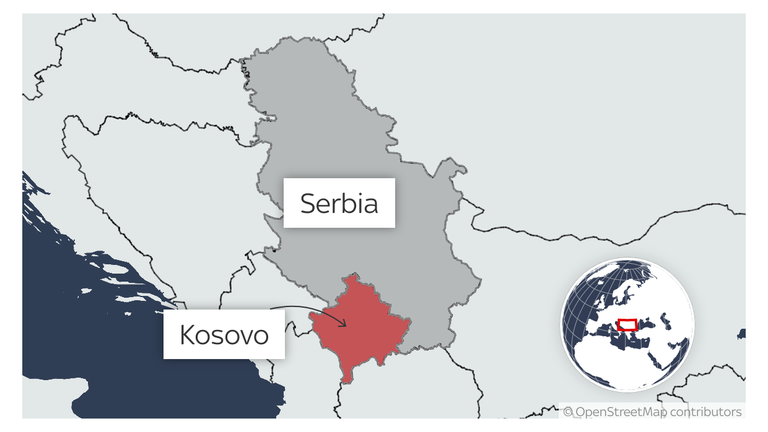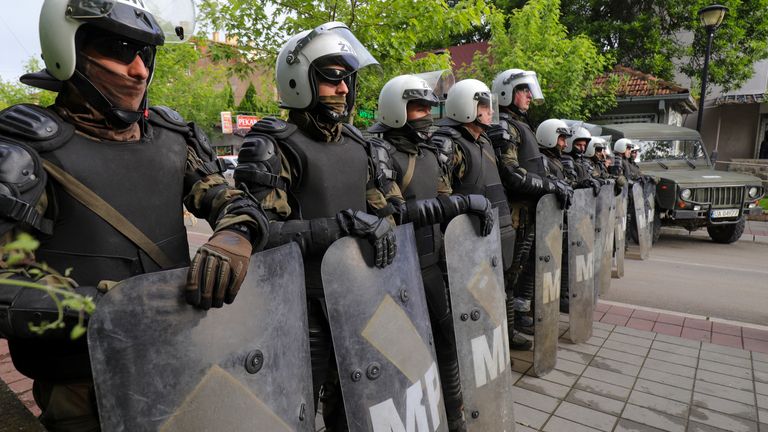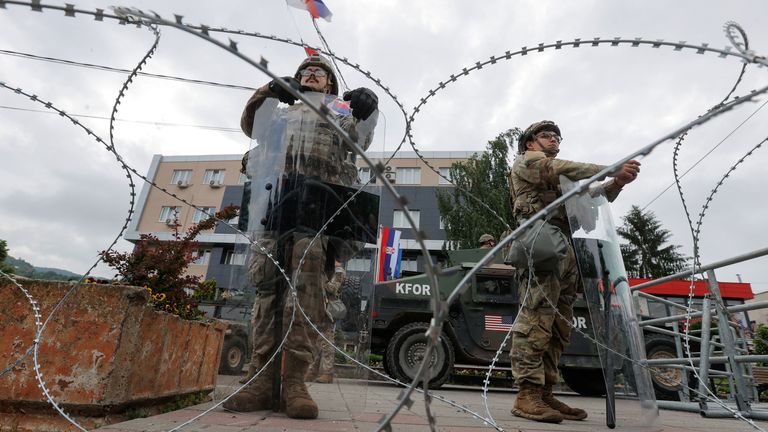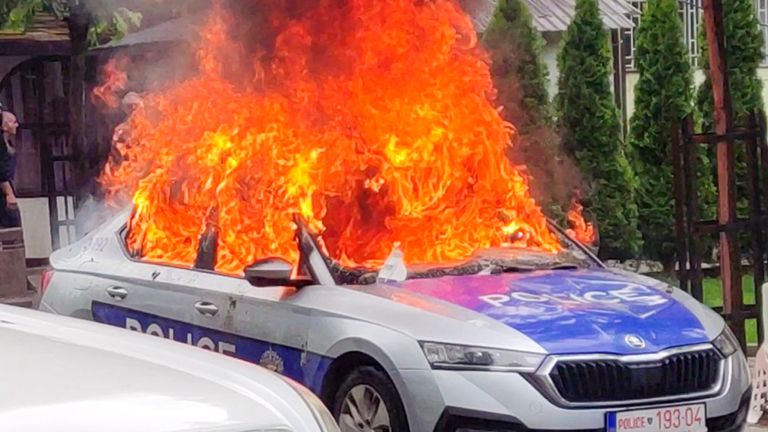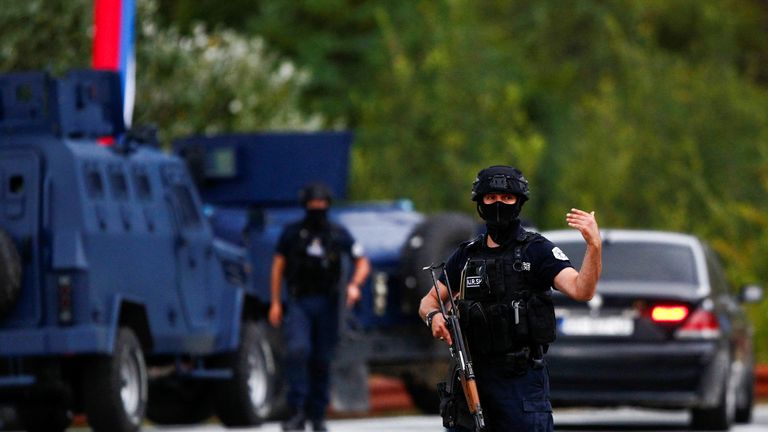Kosovo: Why have tensions flared up with Serbia and why are British troops being sent there?
Last month's clashes at a monastery in northern Kosovo are being described as some of the worst since it declared independence from Serbia in 2008. Now, British forces will be under NATO's command to form part of the KFOR peacekeeping force of around 4,500 troops from 27 countries.
Monday 2 October 2023 15:05, UK
British troops are being sent to Kosovo amid some of the worst tensions with Serbia in more than a decade.
After a fatal firefight between masked gunmen and local police at a monastery in northern Kosovo, the territory's prime minister, Albin Kurti, accused Serbia of orchestrating the attack.
Serbian president Aleksandar Vucic denied state involvement and claimed the gunmen were Kosovo Serbs disillusioned with Mr Kurti's regime of "terror".
Now, members of the 1st Battalion of the Princess of Wales's Royal Regiment are being made available in the region.
Under the new arrangement, they will be placed under NATO's command "if needed, to address the current situation". They will form part of the KFOR peacekeeping force, which consists of around 4,500 troops from 27 NATO and partner countries.
Here Sky News looks at the origins of tensions between the two sides and how they've flared up this year.
Where does the conflict originate?
The conflict in the region goes back centuries.
Kosovo is largely made up of ethnic Albanians, who are mainly Muslim. It gained independence from Serbia, which is mostly Christian Orthodox, in 2008.
Although the US and most EU countries recognise Kosovo as a sovereign state, Serbia doesn't and believes it should still be part of its territory.
There are still several Serb Orthodox monasteries left in Kosovo - mainly in the north.
And Serbian nationalists still view their 1389 battle with Ottoman Turks there as symbolic of their struggle.
13,000 dead and a million displaced
In the years of the Soviet Union, Kosovo was an autonomous province of the former Yugoslavia, solidified by the 1974 Yugoslav Constitution.
But ethnic Albanians there wanted full republic status, with riots breaking out in 1981.
In the late 1980s, Slobodan Milosevic became the president of Serbia.
He began by exploiting tensions with the Serbian minority in Kosovo and by 1989 had abolished Kosovo's autonomous status, imposing direct rule from Belgrade.
In response, in the early 1990s, a peaceful Kosovan resistance movement emerged.
But when it failed to achieve its aims, in 1997 it was superseded by the Kosovo Liberation Army (KLA), which was prepared to use violence to gain independence.
Milosevic's brutal crackdown in 1998 resulted in around 13,000 deaths.
The Serbian leader, who was later charged with war crimes, failed to adhere to a NATO-drafted peace agreement in 1998, triggering a NATO military campaign to end the fighting.
This was championed by then-Prime Minister Tony Blair, who is still seen as a "saviour" by many Kosovans.
After 78 days, mainly of heavy bombing, Milosevic gave in.
In June 1999, Serbia gave control of Kosovo to a temporary UN Interim Administration Mission in Kosovo, which was supported by a NATO peacekeeping force (KFOR).
There were still reprisals by ethnic Albanians, with ethnic Serbs kidnapped or murdered and up to a million fleeing their homes.
After the UK, France, Germany, Italy and Russia helped draft a set of principles for Kosovo's future in the early 2000s, on 17 February 2008 it finally gained its independence.
Read more from Sky News:
Thousands of ethnic Armenians flee
Niger 'doesn't want to fight terrorism anymore'
What's behind India-Canada tensions?
Why have tensions sparked up again this year?
In April, local elections were held in northern Kosovo.
The majority-Serb population boycotted the vote as they still want to be reunited with Belgrade.
This left only ethnic Albanians and other small minorities elected to mayoral and assembly posts.
When they came to take office, Serbs protested in front of municipal buildings to stop them from getting in.
They clashed with NATO peacekeepers and the local police, who used tear gas.
NATO said 30 of its troops, 11 from Italy and 19 from Hungary, were injured in clashes.
According to commander Major General Angelo Michele Ristuccia, 52 Serbs were hurt, three seriously.
The clashes came after Serbia stepped up its military readiness by stationing itself on the Kosovo border late last year.
What happens next?
Ever since the violence of the 1990s, there have been international efforts to de-escalate tensions in the region.
Currently, they are trying to speed up negotiations and come to a fresh agreement.
NATO peacekeeping forces are trying to prevent Serbians from unleashing violence in Kosovo - as this would trigger a wider conflict with NATO allies.
In late May, NATO deployed an extra 700 troops to that end, which now include British ones.
The EU has also tried to normalise relations between the two sides - but to little avail.
With neither of them part of the bloc, they would need to settle their dispute to have any hope of joining.
In the immediate aftermath of the monastery siege, the police presence in the area has been stepped up.


